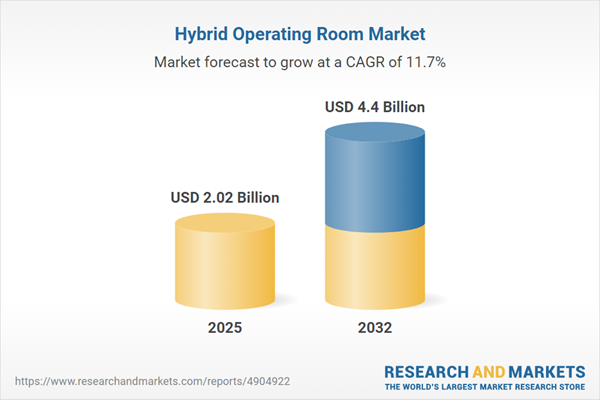Speak directly to the analyst to clarify any post sales queries you may have.
The hybrid operating room market is experiencing pronounced transformation as advanced imaging, navigation, and integration systems converge to shape the future of surgical environments worldwide. Healthcare providers are leveraging this fusion to drive multidisciplinary care, enhance efficiency, and address complex clinical needs with greater precision.
Market Snapshot: Hybrid Operating Room Market at a Glance
The Hybrid Operating Room Market grew from USD 1.81 billion in 2024 to USD 2.02 billion in 2025. It is expected to continue growing at a CAGR of 11.69%, reaching USD 4.40 billion by 2032.
Scope & Segmentation
Comprehensive Segmentation
- Equipment Type: Accessories including ceiling mounts and surgical lights; imaging systems such as CT, MRI, and fluoroscopy platforms; integration systems covering control, display, and visualization; navigation options with electromagnetic and optical technologies; operating tables available in manual or motorized variations.
- Service Type: Consulting services for implementation and workflow optimization; installation, integration, and system design; maintenance services (corrective, preventive); and training delivered on-site or via virtual platforms.
- Applications: Cardiovascular procedures (electrophysiology, interventional cardiology, vascular surgery); neurosurgery (endovascular, stereotactic); orthopedic surgery (joint replacement, spine); urology (endourology, uro-oncology).
- End Users: Ambulatory surgery centers (multi and single specialty); hospitals (academic and community); and specialty clinics (cardiology, orthopedics).
- Region: Americas (US, Canada, Latin America including Brazil, Argentina, Chile, Colombia, Peru); Europe, Middle East & Africa (United Kingdom, Germany, France, Russia, Italy, Spain, Netherlands, Sweden, Poland, Switzerland; UAE, Saudi Arabia, Qatar, Turkey, Israel; South Africa, Nigeria, Egypt, Kenya); Asia-Pacific (China, India, Japan, Australia, South Korea, Indonesia, Thailand, Malaysia, Singapore, Taiwan).
- Key Companies: Siemens Healthineers AG, Koninklijke Philips N.V., General Electric Company, Canon Medical Systems Corporation, Shimadzu Corporation, Getinge AB, Drägerwerk AG & Co. KGaA, Stryker Corporation, STERIS plc, Mindray Medical International Limited.
Key Takeaways for Senior Decision-Makers
- The shift toward hybrid operating rooms is driven by growing demand for minimally invasive and multidisciplinary procedures, offering advantages in workflow, patient safety, and operational throughput.
- Adoption is adapted regionally, reflecting variance in local infrastructure, funding priorities, and regulatory frameworks, necessitating a tailored approach for market penetration.
- Innovations in imaging and navigation, paired with modular integration systems, support flexibility to address evolving clinical requirements and procedural diversity.
- Service specialization—consulting, maintenance, and training—enables providers to extract full value from complex assets while maintaining high uptime and clinical readiness.
- Strategic partnerships between device manufacturers, IT vendors, and service firms accelerate the deployment of integrated solutions while facilitating compliance and interoperability.
Tariff Impact: Navigating 2025 US Trade Measures
Recent US tariff measures have impacted the hybrid operating room market, especially regarding sourcing and procurement strategies for high-value imaging and navigation components. Providers are responding by diversifying supplier networks, considering alternative manufacturing hubs, and evaluating phased technology rollouts to mitigate elevated costs. Manufacturers are leveraging localization and intensified support services to balance project timelines against imported component pricing. Preventive maintenance and asset lifecycle extension strategies also play a major role in managing increased capital expenditure pressure across provider networks.
Methodology & Data Sources
This research synthesizes insights from primary interviews with health system leaders, clinical directors, major manufacturers, and service providers. Secondary data from peer-reviewed studies, industry reports, and regulatory filings complements these findings. Quantitative and qualitative results are reconciled using a robust triangulation framework, further validated through iterative expert reviews to ensure accuracy and actionable depth.
Why This Report Matters
- Enables decision-makers to make informed, timely investments in advanced operating room infrastructure that align with shifting reimbursement and regulatory environments.
- Supports strategic planning through in-depth exploration of technology, service innovations, and emerging clinical applications relevant to diverse care settings and regions.
- Facilitates risk mitigation and opportunity identification amid changing trade policies and procurement challenges.
Conclusion
The hybrid operating room sector is advancing through the integration of imaging, navigation, and service platforms. Organizations strengthening multidisciplinary care, maintaining focus on training and maintenance, and aligning strategy with local needs will be best positioned for sustainable growth and market leadership.
Additional Product Information:
- Purchase of this report includes 1 year online access with quarterly updates.
- This report can be updated on request. Please contact our Customer Experience team using the Ask a Question widget on our website.
Table of Contents
3. Executive Summary
4. Market Overview
7. Cumulative Impact of Artificial Intelligence 2025
Companies Mentioned
The companies profiled in this Hybrid Operating Room market report include:- Siemens Healthineers AG
- Koninklijke Philips N.V.
- General Electric Company
- Canon Medical Systems Corporation
- Shimadzu Corporation
- Getinge AB
- Drägerwerk AG & Co. KGaA
- Stryker Corporation
- STERIS plc
- Mindray Medical International Limited
Table Information
| Report Attribute | Details |
|---|---|
| No. of Pages | 193 |
| Published | October 2025 |
| Forecast Period | 2025 - 2032 |
| Estimated Market Value ( USD | $ 2.02 Billion |
| Forecasted Market Value ( USD | $ 4.4 Billion |
| Compound Annual Growth Rate | 11.6% |
| Regions Covered | Global |
| No. of Companies Mentioned | 11 |









